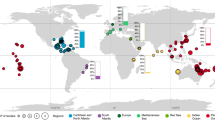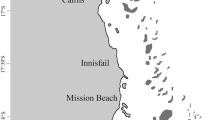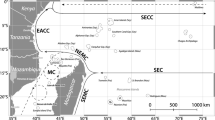Abstract
Parental effects on early life history stages of corals are poorly understood, but with severe environmental disturbances, these impacts may be increasingly important in understanding future coral survival trajectories on reefs. This study investigated whether parental bleaching of Montipora capitata in 2015 influenced symbiont community composition and offspring size three years after recovery. In July 2018, gametes were collected from Reef 13 in Kāneʻohe Bay, Oʻahu, Hawaiʻi, and made selective crosses to produce three different parental phenotype histories: (1) both parents previously bleached (“bleached” phenotype), (2) both parents previously non-bleached (“non-bleached” phenotype), and (3) crosses from a combination of both parental histories (“crossed” phenotype). Parental bleaching history affected the symbiont community composition in three different life history stages—parents, gametes, and larvae, with the bleached phenotype dominated by Cladocopium and non-bleached phenotype dominated by Durusdinium. Symbiont densities were also different between bleaching phenotypes in parents and gamete bundles but not in larvae, with non-bleached phenotypes having slightly higher symbiont densities than their bleached counterparts. Larvae from each phenotype were then exposed to either ambient or high-temperature conditions for 72 h and larvae from bleached phenotype parents were smallest regardless of temperature treatment, indicating maternal effects beyond the direct transmission of symbionts to the offspring. With these findings, larval recruitment to the reef from previously bleached parents is suspected to decline as ocean warming becomes more frequent and severe, potentially leading to generational symbiont community shifts. The direct heritability of thermal tolerance from parent to offspring in M. capitata provides opportunities for restoration by selectively breeding for traits that may increase community resilience to thermal stress.




Similar content being viewed by others
Data availability
Raw data and code are available at github.com/druryc/parent_offspring_symbionts.
References
Abrego D, Willis BL, van Oppen MJH (2012) Impact of light and temperature on the uptake of algal symbionts by coral juveniles. PLoS ONE 7(11):e50311
Babcock RC, Heyward AJ (1986) Larval development of certain gamete-spawning scleractinian corals. Coral Reefs 5:111–116
Bahr KD, Jokiel PL, Rodgers KS (2015a) The 2014 coral bleaching and freshwater flood events in Kāneʻohe Bay, Hawaiʻi. Peerj 3:e1136
Bahr KD, Jokiel PL, Toonen RJ (2015b) The unnatural history of Kāneʻohe Bay: coral reef resilience in the face of centuries of anthropogenic impacts. PeerJ 3:e950
Bahr KD, Rodgers KS, Jokiel PL (2017) Impact of three bleaching events on the reef resiliency of Kane‘ohe Bay, Hawai‘i. Front Mar Sci 4:398
Baird AH, Gilmour JP, Kamiki TM, Nonaka M, Pratchett MS, Yamamoto HH, Yamasaki H (2006) Temperature tolerance of symbiotic and non-symbiotic coral larvae. In: Proceedings 10th Int Coral Reef Symp 38–42
Baird AH, Marshall PA (2002) Mortality, growth, and reproduction in scleractinian corals following bleaching on the great barrier reef. Mar Ecol Prog Ser 237:133–141
Baker AC (2003) Flexibility and specificity in coral-algal symbiosis: diversity ecology and biogeography of Symbiodinium. Annu Rev Ecol Syst 34:661–689
Baker A, Starger C, McClanahan T, Glynn PW (2004) Corals’ adaptive response to climate change. Nature 430:741
Baker AC, Glynn PW, Riegl B (2008) Climate change and coral reef bleaching: An ecological assessment of long-term impacts, recovery trends and future outlook. Estuar Coast Shelf Sci 80(4):435–471
Baker AC Cunning R (2016) Bulk gDNA extraction from coral samples. Open access 1–7.https://doi.org/10.17504/protocols.io.dyq7vv
Bay LK, Doyle J, Logan M, Berkelmans R (2016) Recovery from bleaching is mediated by threshold densities of background thermo-tolerant symbiont types in a reef-building coral. R Soc Open Sc 3:160322
Berkelmans R, van Oppen MJH (2006) The role of zooxanthellae in the thermal tolerance of corals: a nugget of hope for coral reefs in the era of climate change. Proc R Soc B Biol Sci 273:2305–2312
Buddemeier RW, Fautin G (1993) Coral bleaching as an adaptive mechanism. Bioscience 43(5):320–326
Cantin NE, Lough JM (2014) Surviving coral bleaching events: Porites growth anomalies on the Great Barrier Reef. PLoS ONE 9(2):e88720
Caruso C, Rocha de Souza M, Ruiz-Jones L, Conetta D, Hancock JR, Hobbs C, Kahkejian V, Kitchen R, Marin C, Monismith S, Madin J, Gates R, Drury C (2022) Genetic patterns in Montipora capitata across an environmental mosaic in Kāne’ohe Bay. Mol Ecol 20:5201–5213
Chamberland VF, Lantijnhouwers KRW, Huisman J, Hartmann AC, Vermeij MJA (2017) Costs and benefits of maternally inherited algal symbionts in coral larvae. Proc Biol Sci 284:1–9
Coffroth MA, Lasker HR, Oliver JK (1990) Coral mortality outside of the eastern Pacific during 1982–83: relationship to El Niño. Elsevier Oceanogr Ser 52:141–182
Cunning R, Baker AC (2013) Excess algal symbionts increase the susceptibility of reef corals to bleaching. Nature Clim Change 3:259–262
Cunning R, Gillette P, Capo T, Galvez K, Baker AC (2014) Growth tradeoffs associated with thermotolerant symbionts in the coral Pocillopora damicornis are lost in warmer oceans. Coral Reefs 34:155–160
Cunning R, Silverstein RN, Baker AC (2015) Investigating the causes and consequences of symbiont shuffling in a multi-partner reef coral symbiosis under environmental change. Proc R Soc B 282:20141725
Cunning R, Ritson-William R, Gates RD (2016) Patterns of bleaching and recovery of Montipora capitata in Kāneʻohe Bay, Hawaiʻi, USA. Mar Ecol Prog Ser 551:131–139
Cunning R, Silverstein RN, Baker AC (2018) Symbiont shuffling linked to differential photochemical dynamics of Symbiodinium in three Caribbean reef corals. Coral Reefs 37:145–152
Dilworth J, Caruso C, Kahkejian VA, Baker AC, Drury C (2020) Host genotype and stable differences in algal symbiont communities explain patterns of thermal stress response of Montipora capitata following thermal stress exposure and across multiple bleaching events. Coral Reefs 40:151–163
Drury C, Bean NK, Harris CI, Hancock JR, Huckeba J, Martin CH, Roach TNF, Quinn RA, Gates RD (2022) Intrapopulation adaptive variance supports selective breeding in a reef-building coral. Commun Biol 5:486
Eakin CM, Sweatman HPA, Brainard RE (2019) The 2014–2017 global-scale coral bleaching event: insights and impacts. Coral Reefs 38:539–545
Fisch J, Drury C, Towle EK, Winter RN, Miller MW (2019) Physiological and reproductive repercussions of consecutive summer bleaching events of the threatened Caribbean coral Orbicella faveolata. Coral Reefs 38:863–876
Glynn PW (1984) Widespread coral mortality and the 1982–83 El Niño warming event. Environ Conserv 11(2):133–146
Glynn PW (1988) El Niño-Southern Oscillation 1982–1983: nearshore population, community, and ecosystem responses. Ann Rev Ecol Syst 19:309–345
Glynn PW (1993) Coral reef bleaching: ecological perspectives. Coral Reefs 12:1–7
Glynn PW, Maté JL, Baker AC, Calderón MO (2001) Coral bleaching and mortality in Panama and Ecuador during the 1997–1998 El Niño-Southern Oscillation event: spatial/temporal patterns and comparisons with the 1982–1983 event. Bull Mar Sci 69:79–109
Graham EM, Baird AH, Connolly SR (2008) Survival dynamics of scleractinian coral larvae and implications for dispersal. Coral Reefs 27(3):239–539
Hadfield MG (1986) Settlement and recruitment of marine invertebrates: a perspective and some proposals. Bull Mar Sci 39(2):418–425
Hagedorn M, Carter VL, Lager C, Camperio Ciani JF, Dygert AN, Schleiger RD, Henley ME (2016) Potential bleaching effects on coral reproduction. Reprod Fertil Dev 28:1061–1071
Heron SF, Maynard JA, van Hooidonk R, Eakin MC (2016) Warming trends and bleaching stress of the world’s coral reefs 1985–2012. Sci Rep 6:38402
Hughes TP, Kerry JT, Álvarez-Noriega M, Álvarez-Romero JG, Anderson KD, Baird AH, Babcock RC, Beger M, Bellwood DR, Berkelmans R, Bridge TC, Butler IR, Byrne M, Cantin S, Comeau S, Connolly SR, Cumming GS, Dalton SJ, Diaz-Pulido G, Wilson SK (2017) Global warming and recurrent mass bleaching of corals. Nature 543:373–377
Hughes TP, Kerry JT, Baird AH, Connolly SR, Dietzel A, Eakin MC, Heron SF, Hoey AS, Hoogenboom MO, Liu G, McWilliam MJ, Pears RJ, Pratchett MS, Skirvin WJ, Stella JS, Torda G (2018) Global warming transforms coral reef assemblages. Nature 556:492–496
Hughes TP, Kerry JT, Baird AH, Connolly SR, Chase TJ, Dietzel A (2019) Global warming impairs stock–recruitment dynamics of corals. Nature 568:387–390
Hunter CL (1988) Environmental cues controlling spawning in two Hawaiian corals, Montipora verrucosa and M. dilatata. In: Proceedings 6th Inter Coral Reef Symp 2: 727–732
Innis T, Cunning R, Ritson-Williams R, Wall CB, Gates RD (2018) Coral color and depth drive symbiosis ecology of Montipora capitata in Kāne‘ohe Bay, O‘ahu, Hawai‘i. Coral Reefs 37(2):423–430
Isomura N, Nishihira M (2001) Size variation of planulae and its effect on the lifetime in three pocilloporid corals. Coral Reefs 20:309–315
Jones AM, Berkelmans R (2011) Tradeoffs to thermal acclimation: energetics and reproduction of a reef coral with heat tolerant Symbiodinium type-D. Journal of Marine Biology 12:1687–9481
Jones AM, Berkelmans R, van Oppen MJH, Mieog JC, Sinclair W (2008) A community change in the algal endosymbionts of a scleractinian coral following a natural bleaching event: field evidence of acclimatization. Proc R Soc B 275:1359–1365
Jones AM, Berkelmans R (2010) Potential costs of acclimatization to a warmer climate: growth of a reef coral with heat tolerant vs. sensitive symbiont types. PLoS ONE 5(5):e10437
Kitchen RM, Piscetta M, Rocha de Souza M, Lenz EA, Schar DW, Gates RD, Wall CB (2020) Symbiont transmission and reproduction mode influence responses of three Hawaiian coral larvae to elevated temperature and nutrients. Coral Reefs 39:419–431
LaJeunesse TC, Parkinson JE, Gabrielson PW, Jeong HJ, Reimer JD, Voolstra CR, Santos SR (2018) Systematic revision of Symbiodiniaceae highlights the antiquity and diversity of coral endosymbionts. Curr Biol 28(16):2570–2580
Lesser MP (1996) Elevated temperatures and ultraviolet radiation cause oxidative stress and inhibit photosynthesis on symbiotic dinoflagellates. Limnol Oceanogr 41(2):271–283
Lesser MP (1997) Oxidative stress causes coral bleaching during exposure to elevated temperatures. Coral Reefs 16:187–192
Lesser MP, Shick JM (1989) Effects of irradiance and ultraviolet radiation on photoadaptation in the zooxanthellae of Aiptasia pallida: primary production, photoinhibition and enzymic defenses against oxygen toxicity. Mar Biol 102:243–255
Lewis CL, Coffroth A (2004) The acquisition of exogenous algal symbionts by an octocoral after bleaching. Science 304:1490–1492
Little AF, van Oppen MJH, Willis B (2004) Flexibility in algal endosymbiosis shapes growth in reef corals. Science 304(5676):1492–1494
Matsuda SB, Huffmyer AS, Lenz EA, Davidson JM, Hancock JR, Przybylowski A, Innis T, Gates RD, Barott KL (2020) Coral bleaching susceptibility is predictive of subsequent mortality within but not between coral species. Front Ecol Evo 8(178):1–14
Mieog JC, van Oppen MJH, Berkelmans R, Stam WT, Olsen JL (2009) Quantification of algal endosymbionts (Symbiodinium) in coral tissue using real-time PCR. Mol Ecol Resour 9(1):74–82
Muller EM, Rogers CS, Spitzack AS, van Woesik R (2008) Bleaching increases likelihood of disease on Acropora palmata (Lamarck) in Hawksnest Bay, St John, US Virgin Islands. Coral Reefs 27:191–195
Nozawa Y, Okubo N (2011) Survival dynamics of reef coral larvae with special consideration of larval size and the genus Acropora. Bio Bull 220(1):15–22
Padilla-Gamiño JL, Gates RD (2012) Spawning dynamics in the Hawaiian reef-building coral Montipora capitata. Mar Ecol Prog Ser 449:145–160
Padilla-Gamiño JL, Pochon X, Bird C, Concepcion GT, Gates RD (2012) From parent to gamete: Vertical transmission of Symbiodinium (dinophyceae) ITS2 sequence assemblages in the reef building coral Montipora capitata. PLoS ONE 7:e38440
Putnam HM, Gates RD (2015) Pre-conditioning in the reef-building coral Pocillopora damicornis and the potential for trans-generational acclimatization in coral larvae under future climate change conditions. J of Exp Bio 218(15):2365–2372
Quigley KM, Willis BL, Bay LK (2016) Maternal effects and Symbiodinium community composition drive differential patterns in juvenile survival in the coral Acropora tenuis. R Soc Open Sci 3:160471
Roach TNF, Dilworth J, Martin CH, Jones DA, Quinn R, Drury C (2021) Metabolic signatures of coral bleaching history. Nat Ecol Evo 5:495–503
Rocha de Souza M, Caruso C, Ruiz-Jones L, Drury C, Gates RD, Toonen RJ (2022) Community composition of coral-associated Symbiodiniaceae differs across fine-scale environmental gradients in Kāne‘ohe Bay. R Soc Open Sci 9:212042
Rowan R (2004) Coral bleaching: thermal adaptation in reef coral symbionts. Nature 430(7001):742
Sampayo EM, Ridgway T, Bongaerts P, Hoegh-Guldberg O (2008) Bleaching susceptibility and mortality of corals are determined by fine-scale differences in symbiont type. PNAS 105(30):100444–110449
Shearer TL, Porto I, Zubillaga AL (2009) Restoration of coral populations in light of genetic diversity estimates. Coral Reefs 28:727–733
Silverstein RN, Cunning R, Baker AC (2017) Tenacious D: Symbiodinium in clade D remain in reef corals at both high and low temperature extremes despite impairment. J of Exp Biol 220(7):1192–1196
Stat M, Gates RD (2010) Clade D Symbiodinium in scleractinian corals: a “nugget” of hope, a selfish opportunist, an ominous sign, or all of the above? J of Mar Sci 2011:730715
Stat M, Loh WK, LaJeunesse TC, Hoegh-Guldberg O, Carter DA (2009) Stability of coral-endosymbiont associations during and after thermal stress event in the southern great barrier reef. Coral Reefs 28:709–713
van Oppen MJH, Oliver JK, Putnam HM, Gates RD (2015) Building coral reef resilience through assisted evolution. PNAS 118(2):2307–2313
Wall CB, Kaluhiokalani M, Popp BN, Donahue MJ, Gates RD (2020) Divergent symbiont communities determine the physiology and nutrition of a reef coral across a light-availability gradient. ISME J 14:945–958
Ward S, Harrison P, Hoegh-Guldberg O (2000) Coral bleaching reduces reproduction of scleractinian corals and increases susceptibility to future stress. Proc Int Coral Reef Symp 2:1123–1128
Wham DC, Ning G, LaJeunesse TC (2016) Symbiodinium glynnii sp nov a species of stress tolerant symbiotic dinoflagellates from pocilloporid and montiporid corals in the Pacific Ocean. Phycologia 56(4):396–409
Williamson OM, Allen CE, Williams DE, Johnson MW, Miller MW, Baker AC (2021) Neighboring colonies influence uptake of thermotolerant endosymbionts in threatened Caribbean coral recruits. Coral Reefs 40:867–879
Yorifuji M, Harri S, Nakamura R, Fudo M (2017) Shift of symbiont communities in Acropora tenuis juveniles under heat stress. PeerJ 5:e4055
Yuyama I, Nakamura T, Higuchi T, Hidaka M (2016) Different stress tolerances of juveniles of the coral Acropora tenuis associated with clades C1 and D Symbiodinium. Zool Stud 55:1–9
Acknowledgements
We thank Josh Hancock, Jennifer Davidson, Kira Hughes, and the Gates Coral Lab for their help collecting gametes during the 2018 spawning event. Coral fragments and gamete bundles were collected under Hawaii DLNR permit SAP 2018-03 to HIMB. This work was funded by the Paul G. Allen Family Foundation. We dedicate this work to Ruth Gates, who encouraged us to think creatively about the future of coral reefs. This is HIMB contribution 1908 and SOEST contribution 11586.
Author information
Authors and Affiliations
Contributions
CIH, CD, and NKB developed and executed the experiment. CIH, CD, and NKB collected the data. CIH processed samples and analyzed data with guidance from CD and ACB. CIH wrote the manuscript. All authors edited and approved the final version.
Corresponding author
Ethics declarations
Conflict of interest
On behalf of all authors, the corresponding author states that there is no conflict of interest.
Additional information
Publisher's Note
Springer Nature remains neutral with regard to jurisdictional claims in published maps and institutional affiliations.
Supplementary Information
Below is the link to the electronic supplementary material.
Fig. S1
Below is the link to the electronic supplementary material.Fig. S1 Temperature data from conical treatments 0–72 hours post-fertilization. Pictures of larvae were taken at 72 h. Color codes indicate the 6 treatments: ambient bleached (light blue), ambient cross (blue), ambient non-bleached (dark blue), high bleached (light red), high cross (red), and high non-bleached (dark red) (EPS 397 kb)
Rights and permissions
Springer Nature or its licensor (e.g. a society or other partner) holds exclusive rights to this article under a publishing agreement with the author(s) or other rightsholder(s); author self-archiving of the accepted manuscript version of this article is solely governed by the terms of such publishing agreement and applicable law.
About this article
Cite this article
Harris, C.I., Bean, N.K., Baker, A.C. et al. Stable symbiont communities persist in parents, gametes, and larvae of Montipora capitata across historical bleaching phenotypes. Coral Reefs 41, 1627–1636 (2022). https://doi.org/10.1007/s00338-022-02305-z
Received:
Accepted:
Published:
Issue Date:
DOI: https://doi.org/10.1007/s00338-022-02305-z




